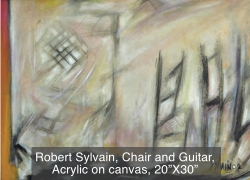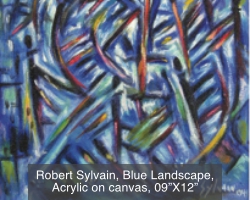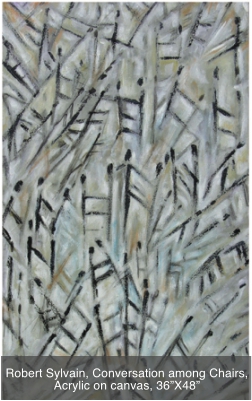Various Styles
There is a traditional approach to painting in which artists run the gamut of techniques and styles from impressionism to surrealism, symbolism to neo-expressionism to postmodernism, and so forth. These artists illustrate their designs in the service of a wide range of concerns, whether philosophical, spiritual, emotional, historical, anecdotal, mythical or symbolical. The paintings by Robert Sylvain fall into these categories.
Robert Sylvain
Sylvain’s paintings have the same effect on viewers as a rollercoaster ride. What excitement! The colors are so vibrant and, at times, so strident that emotions run high and adrenaline overflows.
His collection of paintings depicting chairs doesn’t just convey the sense of relaxation that chairs normally do. Instead, they also convey movement and restlessness, as if they were hot, shaking, growing and moving in such a way that they appear to illustrate a sense of kinetic energy. Even the chairs depicted by Van Gogh don’t exhibit so much energy. Sylvain once admitted that what strikes him the most about his chair paintings are their symbolism. No matter how many different types of chairs there are, and regardless of their common features, each one belongs to a particular hierarchy of importance depending on whom it is supposed to accommodate. The lavishly decorated throne of a king, for instance, is certainly more impressive than the rustic chair of a poor peasant. One can barely imagine the varieties that exist between the most modern and sophisticated chairs, to the most mundane and humble ones.

These chairs are not just ordinary chairs — “Bob” Sylvain infuses them with life. At times, they appear to be alive, filled with excitement. They even seem to have a soul. Sometimes they look like people in a crowd, gesturing, shoving and jostling each other. Often they appear to have heads, arms and legs that seem to be screaming at the top of their lungs as though they’re exhorting oppressed and downtrodden citizens to reclaim their rights, demand justice or cry out for freedom. Sylvain had no intention of depicting functional chairs even though that was what he originally did. In fact, he was searching for his signature style at that time. The recurring subject was nothing but an obsession. He wanted to understand what he was trying to do — to grasp on to the meaning and symbolism involved, but it was to no avail. The idea remained elusive to him until one day he realized that what he was striving to convey was the essence of chairs as vehicles and media, as devices to travel to alternative dimensions and worlds where things are not what they seem to be — a world beyond reality, a world of dreams, phantasmagoria, bewilderment, excitement and happiness.

The chairs, thus, become metaphors for the act of rising up from a degrading position to a more dignified and heroic one, conveying at least a sense of self-respect and pride. Herein resides Sylvain’s magical power as a visionary and gifted artist capable of transcending reality and changing an ordinary object into dialectic for changes. tj

The complete article can be found in Issue #278 of the Tokyo Journal. Click here to order from Amazon.


















